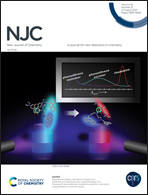Synthesis of hybrids thiazole–quinoline, thiazole–indole and their analogs: in vitro anti-proliferative effects on cancer cell lines, DNA binding properties and molecular modeling†
Abstract
A convenient synthesis under ultrasound (US) irradiation of 4-thiazolidinone, thiazole, dihydrothiazole, and thiazine hybrid compounds containing quinoline and indole nucleus is described. All the title compounds were characterized by NMR and HRMS. The synthetic protocol affords highly selective conversions, short reaction times, simple work-up procedures, and good yields compared with conventional methods. All the synthesized compounds were tested for in vitro cytotoxic activity against glioblastoma (SF-295), leukemia (HL-60), and prostate cancer (PC-3) cell lines. Three compounds (4c–e) presented moderate to high activity against all cancer cell lines evaluated. Compound 4c stood out with its promising cytotoxicity activity against the HL-60 cell line with an IC50 value of 2.41 μM and an SI of 10.5. The electrochemical behavior of 4c was studied using differential pulse voltammetry (DPV) on a glassy carbon electrode modified with dsDNA and with ssDNA in the solution. As a result, the pre-concentration of the compound on the dsDNA biosensor surface and modification of the oxidation currents of guanosine and adenosine bases in ssDNA experiments demonstrated an interaction between 4c and DNA. The affinity of 4c was evaluated against ctDNA by exploring spectroscopic techniques, showing that this compound acts preferentially as a groove binder. Molecular docking and dynamics simulations proposed that 4c interacts via groove binding and intercalation, corroborating the experimental results. The dominating interactions were conventional hydrogen bonds and van der Waals forces. Finally, our findings suggest the 4c derivative to be a potential anticancer prototype against HL-60.



 Please wait while we load your content...
Please wait while we load your content...